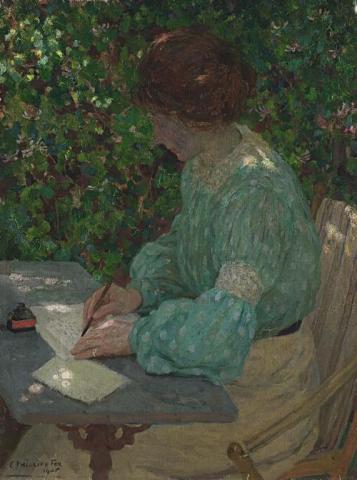(HER) LETTER, 1905
Emanuel Phillips Fox
oil on canvas on hardboard
61.5 x 46.0 cm
signed lower left: E. PHILLIPS FOX / 1905
Mr & Mrs Robert Campbell, Adelaide
Thence by descent, Jean Campbell, Canberra
Zubans, Ruth, E. Phillips Fox: His Life and Art, The Miegunyah Press, Melbourne University Press, 1995, cat. 208, colour plate 36
In May 1905 Emanuel Phillips Fox married Ethel Carrick, leaving London for Paris, where they lived until 1913. Reminiscent of his friend and fellow Australian Rupert Bunny after his marriage in 1902, it ushered in a period that Fox's biographer, Ruth Zubans has described as 'one of the most fertile in Fox's career.'1 Both Fox and Bunny shared an interest in subjects featuring elegant women in domestic scenes, much favoured in Parisian art circles of the time. They also painted happy moments in the Luxembourg Gardens and at the fashionable beachside resorts of Trouville or St Georges de Didonne. Similar subjects appear in the work of Ethel Carrick. In scale, Fox's paintings ranged from the large Salon works, such as Al Fresco, c.1905, in the collection of the Art Gallery of South Australia, to the more intimate in size and subject, Arranging Flowers, c.1906, in the Art Gallery of New South Wales. The emphasis is on the feminine, expressing ideals of womanhood captured while reading, at afternoon tea, and by lamplight, all of private moments of pleasure and relaxation.
La belle époque and the English equivalent, the Edwardian age, were dominated by femininity, the femme fatale of the Symbolists having been domesticated, and once favoured images of the Madonna and Child converted into secular versions of motherhood. Prior to (Her) Letter Fox had painted the beautifully lyrical A Love Story, 1903, in the Ballarat Fine Art Gallery, and the sophisticatedly elegant Reverie, 1903, in the Musée d'Orsay, Paris. He exhibited his first painting of Mother and Child at the 1907 Royal Academy, London, and the following year produced Motherhood, now in the collection of the Art Gallery of New South Wales.
In (Her) Letter the mood of quietness is achieved by a combination of the stillness of the pose and the overall shaded tones. This is given enlivening touches by the patches of sunlight falling on chosen parts of the composition - especially the writing table and sheets of paper. The intimacy of the painting is engendered by the engagement of a single figure placed close to the viewer, of a woman seated in a quiet corner of a shaded part of the garden writing a letter. In two later versions, The Letter, 1908, (private collection) and The Letter, c.1908-10, (Queensland Art Gallery), the subject is changed to the reading of a letter received, being interior scenes of single standing figures of women in profile, wearing long white dresses.
1. Zubans, op. cit, p. 121
DAVID THOMAS
